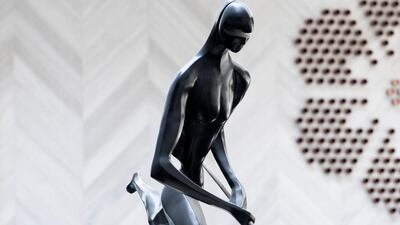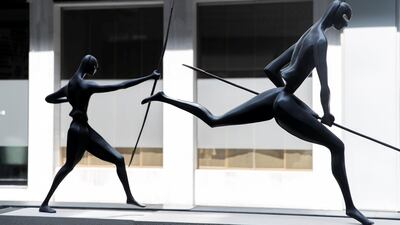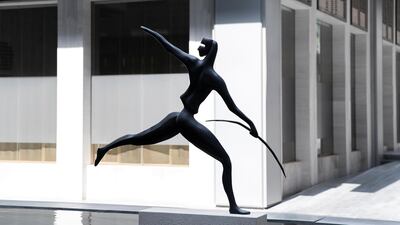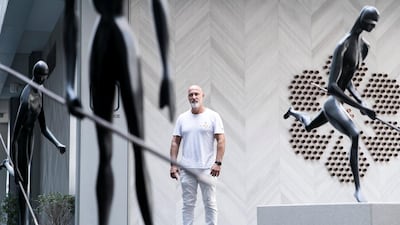Antonio Signorini found inspiration in the cave paintings of a stretch across the Middle East and North Africa from 40,000 years ago for his pieces that are currently on display at Dubai’s DIFC.
“There are cave paintings in southern Europe, in France and Spain,” the Italian artists says. “The people who made them there tended to paint animals – mammoths, horses, bison. The cave paintings in Mesopotamia were full of figures of people. You can say that those in Europe were more concerned with the world around them, and those in Mesopotamia were concerned with what it was to be human itself.”
Fascinated by these paintings, Signorini pored over books and images, visiting the caves he could. Then he began sketching the figures in poses inspired by the Paleolithic paintings – running with spears aloft, or about to lance a spear forwards – and cast them in bronze in a foundry near Florence, where he was born. He gave them thick muscles, but tapering arms, nipped-in waists and straight, thin apertures where their eyes would have been.
“I left their eyes blank,” he says. “I wanted the viewers to see themselves in the figures. They aren’t man or woman. They are humans, concerned then, with the same things that worry us now.”
The bronze works weigh 150 kilograms each and balance precariously on slender feet or the tips of their toes. Titled The Warriors, the sculptures made their debut in March in the DIFC courtyard by the Four Seasons, and were meant to only stay up for three weeks. But "they look so perfect in the space", Signorini says, and they are still standing – with plans to make them permanent.
A tall, broad-chested man, Signorini has the appearance of an artist at ease with heavy bronzes and totemic figures – a warrior-like sculptor, wrestling with physicality. But his solicitous, philosophical demeanour belies this impression. Sitting at lunch, he tells me how his 3-year-old son is having trouble settling at nursery. "The pain you feel when you watch your child like that – it's primal."
He laughs at his country’s cliches, too: “Italians say children are a miracle, but sometimes you have to work to enjoy them.” And he bounds into an excursus on the importance of Leonardo da Vinci – whom he named his son after – in reversing medievalist doctrine that put death before life. “The monks would say to each other: ‘Remember you will die, brother.’ But Leonardo understood that to mean that life is to be valued.”
With The Warriors, Signorini sought to bring the past into the present, sculpting the ancient forms in such a way that they look modern. "I wanted them to be about movement," he says. "As if there were not a part of them that was still." He deepened this impression by setting the figures within a reflective pool of water, an idea that only came after the casts were struck. Other appearances of the forms have followed this lead, such as The Warriors' installation this summer at Samir Kassir Square in Beirut, which commemorates an assassinated Lebanese journalist. "They aren't warriors in the sense of fighting each other, but in the sense of fighting to live," he says, noting the symbolism of the Beirut context.
Signorini moved to Dubai two years ago, partly out of frustration over Brexit – he and his family were previously living in London – and partly out of enthusiasm for his next project. Signorini came across the findings of Saruq Al-Hadid, an archaeology site on the Dubai-Abu Dhabi border that, legend has it, was spotted by Sheikh Mohammed bin Rashid, Vice President and Ruler of Dubai, while he was flying overhead in a helicopter.
In the middle of the desert, archaeologists found evidence of a village from the Iron Age. "They found fishing hooks and fish bones, and tiny bronze items," Signorini explains. Before the process of desertification, he continues, this is proof that there were villages along trade routes. Though the site now sits 50km inland, the fish hooks and bones indicate this would have been a coastal village.
Spending weeks at the Saruq Al-Hadid Archaeology Museum in Dubai, he examined key motifs from the finds, such as a gazelle, with a wide face and broad ears, and sculpted a figure along the same, naive lines, working in his Alserkal Avenue studio. He enlarged a small, intricate ring that he says must have been a bead on a necklace, and made a standing tower of the stacked items, twirled together to represent DNA, for a public sculpture that he expects to go on show in Dubai soon.
“These items are in all of our DNA,” Signorini says.
_______________________
Read more:
Curators of next UAE National Pavilion say they want to ‘do something that hasn’t been explored’
Can Lantian Xie meet expectations set by his debut show with follow-up ‘Full Special’?
Malala Yousafzai 'honoured' by new portrait at UK’s National Portrait Gallery
_______________________





